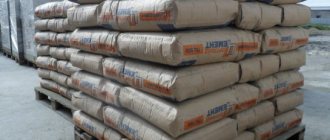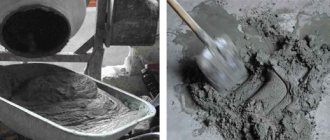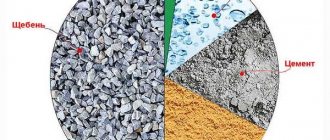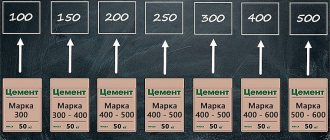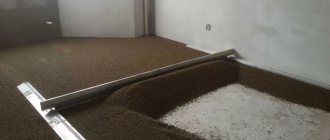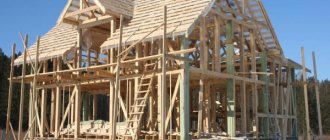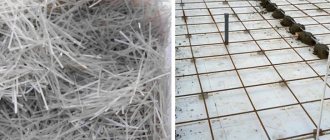Types of cement mixtures
Depending on the composition and purpose of use, the solution is divided into brands:
- M150 and M200 – for screeds;
- M50, M100, M150, M75, M200 and M125 - for masonry;
- M10, M50 and M25 - for plaster.
All varieties differ in the quantitative sand content and proportions. Changing the ratio of the main components allows the use of such building material for various jobs.
The grade of mortar is an indicator of the strength of the structure built using it. The proportions of the ingredients usually depend on what brand of cement mortar is needed. Often, cooking instructions are printed by the manufacturer on the packaging.
Of course, you can order a ready-made mixture of the desired brand (currently they sell dry ready-made mixtures for foundations, plaster or screed, to which you just need to add the required amount of water). But mixing it yourself will save you money.
Correct cement mortar
When mixing the solution, to increase its strength properties, certain additives must be added to this mixture.
Cement mortar is considered the main material during any construction. In recent years, innovative technologies have emerged to improve the quality of cement mortar. If it is necessary to produce a large amount of this material, then special devices are often used. If the building is small, you can make cement mortar without using certain units. All you need for this is some tools and, of course, your own strength. With the correct distribution of the appropriate proportions, you can build a fairly strong structure.
Rules for determining the required grade of sand-cement mass
The technology requires that the brand of mortar matches the brand of material used (brick, blocks). For example, if the masonry is built from brick of grade 100, then the cement mass should be M100. If you follow this rule, the result will be a solid, homogeneous brick structure.
If the grade of material used is high, for example 350, then you should not strive for a match, as this will significantly increase the cost of construction. The generally accepted proportions are 1 part (for example, a bucket) of cement and 3 parts of sand (1 to 3). When preparing concrete for pouring the foundation, 3-5 parts of crushed stone are added to this proportion.
There is a huge range of different types of cement on sale, differing in brand, manufacturer, properties and shelf life. Portland cement is especially popular among professional builders because it is characterized by a high level of water resistance, frost resistance and strength. It hardens well in almost any weather.
In what proportions should cement be diluted?
The correct proportions can vary significantly between different mixtures. Therefore, before mixing, it is necessary to decide for what purposes a particular solution will be used.
Important! The consistency of the solution changes depending on the proportions of the components.
The most popular mortars that require cement are:
- Mixture for plastering walls. To prepare it, it is recommended to use 1 part cement and 3 parts sand. The volume of water is usually equal to part of the cement, but it cannot be added immediately, so it is poured into the dry mixture in small portions to obtain the desired consistency. If you need to carry out internal plastering work, then the M150 or M200 grades are selected, and if you plan to plaster the facade, then the M300 grade is suitable.
- Brick masonry mortar. Here we use 1 part cement and 4 parts sand. The optimal brands for this work are considered to be M300 and M400. Often slaked lime is added to this mixture, acting as a binder. Its amount is calculated as 0.2 parts per 1 part cement. This substance produces a plastic solution, which is quite easy and convenient to work with. The amount of water may vary, as it is added gradually until a solution of the desired density is obtained. It is important to make a mixture that will not flow from the spatula, tilted at an angle of 40 degrees.
- A mixture designed to create a floor screed. Typically the following proportions are used: 1 part cement to three parts sand. The M400 brand is considered optimal. Water is added in a volume of ½ the amount of cement. To make a rare solution, it is recommended to gradually add water, as it is important that the mixture stretches well, which ensures that all voids in the base are filled.
- Concrete. To create concrete, use 1 part cement, 2 parts sand and 4 parts gravel. If this solution is made to form the foundation of a building, then it is necessary to purchase material grade M500. The amount of water is equal to ½ of the cement. The water must be clean and potable, and it is recommended to stir the composition with a concrete mixer (how to choose a concrete mixer for your home and garden). The entire solution must be used within an hour after receiving it.
Important! If you want to get a mixture in sufficient quantity to form the foundation of a building, then you will need a fairly large amount of it, for which special equipment is used, represented by a concrete mixer.
Often, ready-made solutions are purchased at the factory, and in this case you need to make sure that the mixture is created immediately before sending it to the customer. Before purchasing, we study all the documents for the mixture in order to know what components it consists of, as well as what parameters it has.
It is necessary to choose the right grades of material to form different solutions. If the mixture is intended to create brickwork, then you can use grades M50 or M100, and if you need to make a foundation, then it is advisable to choose grades from M300 to M500. The higher the grade of material, the more durable and reliable the solution will be.
Rules for preparing the mixture
When mixing by hand, it is recommended to dilute cement in a metal or plastic container: a trough, basin, old bathtub, bucket. To mix, you will need a shovel, trowel, spatula or drill with attachments. For large volumes of prepared cement mortar (from 1 m3), it is advisable to use concrete mixers. All equipment and the mixing area are prepared in advance, as are the introduced components. The viability of the cement base is 1–1.5 hours; the mixture is used immediately after preparation.
The sand is pre-washed and dried; wet filler cannot be added - this leads to a violation of the W/C ratio. The characteristics of the cement-sand composition depend on the properties of the binder and the selected proportions (to check compliance, divide the factory strength grade by the number of sand shares). It is best to dilute cement with clean water (melt, rain or drinking water will do); taking it from open sources is not recommended. To impart plasticity, it is allowed to introduce additives (liquid soap, lime, plasticizers), but not more than 4–5% of the total proportion of binder.
The sequence of loading the components depends on the mixing method: with manual mixing, sand and cement are first sifted into the container, then they are mixed with liquid. When using a concrete mixer, on the contrary, water is poured into the bowl, then fillers. It is better to dilute additives and impurities immediately, an exception is made only for reinforcing fiber. In any case, the cement mortar is mixed for no more than 5 minutes, during which time it should reach a uniform consistency. A correctly prepared composition remains on the trowel or spatula and flows smoothly when turned over; no lumps or undiluted particles are observed in it.
Basic rules for creating a high-quality solution
The basic rules used in the process of creating a high-quality mixture include:
- it is allowed to mix the components and fill them with water in a metal or plastic container;
- the size of the container depends on the volume of solution that needs to be obtained in the end;
- Initially, the dry components are mixed, namely sand and cement, and they must be sifted through a fine sieve in advance so that they are completely free of any large impurities or inclusions;
- Next, clean water is added to this mixture, and it is desirable that it be cold;
- while adding water, the mixture must be thoroughly mixed to obtain an optimal consistency, similar to sour cream;
- It is quite easy to determine the desired thickness, since the mixture must stay on the spatula, and at the same time it must not flow from it.
Important! If dirty sand is used, then before use it is necessary to soak it in water, after which it is mixed well, the water is drained and the sand is dried.
The resulting solution has optimal parameters for an hour and a half, so it is necessary to use it for its intended purpose within this time, and if this does not work, then you will have to make a new mixture.
Filler ratio
The main measure is the proportion of binder. Depending on the purpose of the composition, the following proportions of the introduced components are used:
1. To prepare plaster: 1:3, W/C ratio does not exceed 1, it is recommended to dilute the composition in portions. When carrying out work indoors, the minimum strength grade of cement is M150, for facades - M300. To impart plasticity to the plaster, it is allowed to introduce lime (no more than 50% of the proportion of sand).
2. When mixing masonry mortar: 1:4, binder strength grade is not lower than M300. Lime is introduced exclusively in slaked form and no more than 0.3 of the share of cement. The ideal W/C ratio is within 0.5; to add plasticity, add 50 g of liquid soap. Masonry compositions are prepared in strict sequence: first, water is introduced into a container or concrete mixer, then fillers.
3. For foundation work: 1:2:4 (cement, sand, crushed stone, respectively), the proportion of water is taken equal to the volume of binder. Portland cement from M400 and coarse filler from hard rocks are used, mixing is carried out in a concrete mixer.
4. When pouring a concrete floor screed, it is necessary to dilute high-grade cement with sand in a ratio of 1:3, with a W/C ratio of 0.5. The composition should follow the trowel and fill small voids; it is better to knead it by force.
5. When ironing floors, a mixture of cement and sand is prepared in a 1:1 ratio. Liquid glass or lime should be diluted in water in advance, at a ratio of no more than 0.1 to the proportion of binder.
When preparing concretes and compositions with various fillers, cement is introduced into the solution without mixing with sand; in all other cases, it is advisable to sift them together. In addition to pouring clearly measured shares, the correctness of the proportions is determined by the brand of binder (not lower than the required one; if there is any doubt about the quality or freshness, its consumption is increased), the cleanliness and dryness of the sand, the strength and flakiness of the crushed stone (for concrete). The most difficult thing is to choose the water-cement ratio; it is recommended to first use 85% of water, then gradually introduce the rest.
The question often arises: how to dilute cement with liquid soap. This additive is very popular in private construction; it is the cheapest plasticizer. But excess foam is harmful; it is better to wait 3-4 minutes for it to shrink and only then introduce the cement-sand mixture (and in small portions). This increases the kneading time by about 5 minutes. The total proportion of any impurities (including coloring minerals) should not exceed 10% by weight of the binder, otherwise the quality of the prepared solution is sharply reduced (adhesive properties are leveled).
Calculation of proportions
Ready-made cement mortars differ in density. It is expressed in grades (M) or classes (B) and is determined by a digital designation from 50 to 500. The most popular types of mixtures are:
- M100 – masonry mortars intended for bricks, blocks and ceramic tiles;
- M150 – materials for plastering surfaces.
- M200 – for floor screeding, roof installation, rough plaster;
- M250-500 – for preparing concrete mixtures.
Its proportions depend on the brand of cement and the type of solution being prepared.
Masonry mixtures
To prepare masonry mortar, branded cement, sand and slaked lime are used. The last component neutralizes carbon dioxide, which is formed during the hardening of cement stone.
The proportions of the mixture depend on the brand of cement: M400 or M500. Solutions mixed with M500 include:
- 1 bucket of cement;
- 3 buckets of sand;
- 0.2 buckets of slaked lime.
The water-cement ratio in this case is 1:1.
Solutions prepared with M400 cement include:
- 1 bucket of cement;
- 2.5 buckets of sand;
- 0.3 buckets of lime.
The water-cement ratio is also 1:1.
The brand of ready-made mortar varies from M150 to M200 and must match the brand of brick.
Plaster dough
When plastering surfaces, builders use spraying, priming and finishing compounds. They also contain M400 cement, filler and water.
The preparatory layer includes:
- 1 bucket of cement;
- 4 buckets of sand;
- 1 bucket of water.
The primer paste is mixed in the following proportions:
- 1 bucket of cement;
- 2 buckets of sand;
- 1 bucket of water.
Plaster is prepared from cement, water and gypsum:
- 1 bucket of cement;
- 2 buckets of plaster;
- 1 bucket of water.
Add 1/10 of a bucket of slaked lime to gypsum solutions to increase the strength of the composition.
Expert advice
It must be diluted at an ambient temperature of +5 °C. If possible, use a concrete mixer, this increases the homogeneity and quality of the solution. With automatic mixing, the sequence of loading components depends on the size of the fractions: from small to large. The finished solution is unloaded and used immediately; the higher the cement strength grade, the faster it sets. To improve performance it is recommended:
- introduce frost-resistant or hydrophobic additives (relevant for concrete);
- when mixing plaster, replace part of the sand with perlite (to increase heat-insulating properties);
- make a test batch to check the quality of the components;
- If possible, use special dispensers.
Tips and tricks
When planning to prepare a cement-sand mixture, you must immediately decide in what proportion the different components will be taken, what grade of strength is needed, and what the main properties are.
It all depends on the scope of application of the mortar - so, if M50 or M75 is suitable for brickwork, then for screed prepare at least a mixture of M150, 200 and higher. The composition of any CPS includes cement, sand, water, but the result is different depending on the ratio.
Some tips from the experts:
- To prepare a plastic mixture, you can add liquid soap to the solution, previously thoroughly mixed with water.
- You need to know how to properly dilute cement and other components: first, all the dry substances are mixed, then water is added in small portions so that you can control the thickness of the mixture and achieve the ideal consistency.
- When preparing masonry mortar, take into account the brand of building material from which the walls are built. It is desirable that the parameters coincide - then the wall will have a homogeneous structure, reliable and durable.
- Before you make your own cement for plaster, you should take care of purchasing perlite. If you replace some of the sand with it, you will be able to achieve higher thermal insulation characteristics.
- For work, we use exclusively fresh cement, without lumps, produced according to technology and stored in optimal conditions - in this case, it will be possible to achieve the most uniform mixing and high adhesion.
- Detergent or soap is also added to the cement (the proportions remain the same, it is simply mixed with mixing water) to increase adhesion.
- The solution is best prepared in a container made of metal, plastic or wood.
- To thoroughly clean the sand from impurities that can reduce its strength, you can soak it in water for a short time.
- The consistency of the finished cement-sand mixture is usually checked with a trowel: the solution should be distributed evenly over the tool, but not run off (it is worth remembering that this rule works in the preparation of standard mixtures; for some tasks other properties may be important).
- The finished DSP is used for an hour after mixing, until the solution begins to thicken and harden. Therefore, you need to immediately prepare the required volume - exactly as much as you can produce in an hour.
- It is forbidden to dilute an already hardened solution with water, as it immediately loses its properties and can cause destruction of the structure/building.
- When mixing a mixture in a volume greater than 2 cubic meters, no drills or attachments will help - only a concrete mixer or ordering the required volume at the factory.
- The solution, which is planned to be used where minimal loads and low mass are noted, can be prepared with a reduced volume of sand. But this approach is only possible on the condition that before properly mixing the DSP, the master has precisely determined the specifics of the application and the remaining solution will not be used for the implementation of any other tasks.
- Mixing the cement-sand mass should last at least 20 minutes - this way the solution will be homogeneous and of high quality.
- The ratio of the proportions of the components is looked at in GOSTs and SNiPs (the opinion of experienced craftsmen is allowed), as well as in the recommendations of the manufacturer of cement, dry mix, etc.
Cement-sand mixture is a universal material that can be used to perform a whole range of works, obtaining the most durable and strong structures. Provided you select high-quality materials and follow the technology for preparing the mixture for the task at hand, everything can be accomplished quickly and easily.
Mixing Features
Before starting work, it is recommended to sift the ingredients together through a construction sieve, so the composition becomes homogeneous. It is better to mix cement with sand not with your hands, but with the help of tools: a concrete mixer or a drill with an attachment. It is desirable that the fraction size be in the range of 0–2 mm; any impurities negatively affect the characteristics of the solution. Testing sand for the presence of clay is very simple: just dilute it in a glass container with water; if cloudy suspensions are observed, you should buy another one. You should also determine the quality of the cement: fresh cement spills through your fingers and has a light gray or greenish tint, there are no lumps in it.
To properly dilute the solution from these components, it is recommended to adhere to the following technology:
- Pour water into the container in a volume equal to the cement (or in other required proportions). Part of the liquid is left; for wet sand, the W/C ratio is chosen slightly less than the standard one.
- Dilute liquid soap or detergent in water. This step is optional, but such an additive increases the adhesion of the future solution.
- Pour half of the fine filler (or part of the sifted composition) into the container. At this stage, it is necessary to dilute cement with sand in a proportion selected taking into account the intended purpose of the prepared mixture and the relevant standards.
- Pour in all the cement and turn on the concrete mixer or construction mixer. After two minutes of mixing, add the rest of the sand.
- Check the consistency of the solution and add the rest of the water in small portions as necessary. A properly prepared mixture slides (rather than flows) off the trowel; when cut with a spatula, there are no dry particles, but the drawn line does not blur.
- Add modifying additives (if needed) and mix everything again.
Violation of proportions leads to cracking of the solution after hardening or its disintegration. It is important to select them in advance, calculate and buy the required amount of material. The viability of the finished solution lies within 1 hour, during which time it must be completely used for its intended purpose. It is unacceptable to re-dilute a mixture that has frozen in a container.
Useful tips
When planning to mix putty for external or internal work on leveling the surface of walls and ceilings, you need to know some nuances that will make the process of preparing the mixture and working with it easier and faster.
All containers and tools must be clean so that there are no traces of dirt or particles of other building material on them. All additives will cause the putty to harden faster and make working with it more difficult. You need to wash everything and mix a new portion of the mixture, otherwise dried lumps will damage the finished surface.
The optimal amount of solution is considered to be enough for a half-hour work process, otherwise the putty will begin to dry out and will be very difficult to apply. By making the mixture too thick, its service life will be significantly reduced. A very thin solution will spread on the wall, leaving streaks and stains that will be difficult to remove.
If the solution is prepared, settled and mixed again, then no ingredients can be added to it.
You can make the mixture without a mixer, using a medium-width spatula for mixing.
If for mixing with an electric device water is poured in and then putty is poured in, then in the manual version it’s the other way around. Having poured a certain amount of putty, you need to add a small amount of water to it.
Building materials are updated annually; powder versions of putty are being replaced by paste types, which are sold ready-made. You can and should use them, the main thing is to choose a trusted manufacturer, look at the date of manufacture and, if necessary, dilute them a little with water.
The cost of such products is much higher, but there are no costs for preparing the mixture, you do not need to carry additional equipment, and the work process can begin from the moment you open the container itself.
The starting putty functions as a surface corrector, which is why it is often applied in a thick layer. To make the work more convenient, the work is carried out in two stages. The first involves grouting all cracks and irregularities and pre-processing the wall, while the second more carefully hides all imperfections and forms a smooth surface.
The finishing putty is applied in a thin layer, and after using it, the walls are rubbed down, finally leveling.
General recommendations for preparing solutions
Conventionally, all cement mortars can be divided into: plaster (with strength grade from M10 to M50), masonry (from M50 to M200, respectively), used for pouring screeds or as a basis for concreting building structures (M150 and M200). The selected proportions significantly influence this indicator, in particular, each additional share of fine filler reduces it. For example: if you dilute Portland cement M400 with sand in a ratio of 1:4, then the final grade of solution will be M100. The less cement, the looser and more porous it will be.
There is a requirement: the mortar used to connect brick or concrete must not be inferior in strength to the brand of the product itself. Ideally, they coincide, then the constructed structure will be monolithic and homogeneous. This rule applies mainly to masonry mixtures; it is also advisable to take into account such characteristics as frost resistance and water resistance. That is, when installing foundation blocks, it is advisable to introduce hydrophobic additives into the connecting solution.
What mortar is needed for laying bricks
A properly prepared masonry mixture must satisfy a number of requirements.
Important points:
- selection of the optimal recipe;
- use of quality ingredients;
- preparation of raw materials;
- compliance with cooking technology.
Compliance with technological recommendations and correctly selected proportions of masonry mortar ensures:
- the required plasticity of the working mixture. The effectiveness of filling irregularities, the absence of voids and cavities in the masonry being constructed depends on compliance with this parameter;
- duration of setting. It is problematic to use an increased volume of quick-hardening mixture. Adding lime allows you to increase the setting time;
- increased strength properties. After hardening, the strength of the cement mass increases. Brick walls are not deformable due to the high strength of the binder mixture.
Mixing the mixture in a makeshift trough
There is a peculiarity that the mortar for brickwork has - the proportions and ingredients used ensure its transition from the current state of aggregation to the solid. During the hydration process, strength increases, and the binder mixture connects the bricks into a single mass. Regardless of the proportions of the masonry mortar, it must contain the following components:
- binder. The binding component, when interacting with water, gradually hardens and combines the remaining ingredients of the working mixture;
- aggregate. It allows you to improve mechanical characteristics, as well as increase the volume of the masonry mixture;
- water. Water is added to the required consistency, reacts with the binder component, ensuring the normal course of the hydration process.
The following are used as binders:
- Portland cement;
- lime;
- lime-cement mixture.
The masonry composition is mixed using sifted river or quarry sand. Foreign inclusions in the form of particles of clay, grass or roots are not allowed. The introduction of fiber makes it possible to increase the strength properties of the mixture. The concentration of water affects the ease of work.
Mortar for laying bricks in a concrete mixer
In addition to the main ingredients, additives are introduced:
- antifreeze components. Prevent water crystallization at subzero temperatures and ensure normal hydration;
- plasticizers. They increase the workability of the working mixture, make it easier to work with, and also improve its performance characteristics;
- hardeners. Provide accelerated polymerization of the binder, reduce the duration of strength development;
- dyes. The introduction of pigments allows you to change the color scheme of the material, which has a positive effect on the aesthetic perception of the brick wall.
The brand of mortar for bricklaying depends on the ratio of the components. With an increase in the proportion of sand, the grade decreases, and with an increase in the proportion of cement, it increases. Various brands are used, of which the most common is M75. In this case, the proportion of cement and sand for bricklaying, as well as the amount of lime, is expressed in the ratio 1: 5: 0.8. Building materials marked M75 reliably bind various types of bricks and natural stone, ensuring the stability of buildings.
This is interesting: Ruukki metal tiles - let's take it apart together
Recommended mortar proportions for plaster mixtures
When carrying out internal work, you will need cement from M150; for cladding facades you need a higher grade - M300. The proven proportions for plastering walls are 1:3. In this case, it is recommended to mix sand with cement before mixing and gradually dilute the resulting dry mixture with water. The result is a homogeneous mass that does not flow off the trowel when tilted at 45°; the W/C ratio is chosen to be ?1. To increase plasticity, lime can be diluted and quenched in added water (0.2–0.3 parts of the amount of cement); such a solution is applied more thinly. To give the plaster thermal insulation properties, sand is partially replaced with perlite.
How to properly dilute
Before preparing the mixture, you need to find out how to dilute the cement correctly. Changing the order of work and violating the technology entails a decrease in the technical characteristics of the material, which is unacceptable.
How to dilute cement and other components correctly:
- Filling the container with one layer of cement, then a layer of sand and alternating until the number of layers reaches at least six. Cement and sand should be poured in the form of a bed with a total height of up to 30 centimeters.
- Mix the dry ingredients in a container with a shovel until a homogeneous mass is obtained. Sift the composition through a sieve with 3x3 millimeter mesh. This is necessary to ensure uniformity of the composition.
- After all the components are mixed (sand and cement), the solution can be mixed. Water is added carefully and gradually, slowly, fully controlling the density level of the CSP.
When preparing a solution, the ratio of sand and cement, the quality of materials and water play a key role. So, it is important to use the liquid at the right temperature - the water should not be very hot and not very cold, as close as possible to the natural environment. The air temperature should be above +5 degrees.
Recommended proportions of mortar for filling the floor
Fresh high-grade Portland cement (from M400) is used for screeding. The classic proportions for filling the floor are 1:3. The W/C ratio does not exceed 0.5, the solution should stretch and fill the smallest voids, but be free of bubbles. To obtain the desired homogeneity, it is kneaded using a construction mixer. The components must be sifted. Due to the small amount of liquid, the solution sets quickly; it must be used within half an hour after mixing.
Pouring and leveling the floor
To make the floor perfectly flat, it is filled with cement mortar. This is a very important part of the work and it must be done correctly. The floor screed is laid on gravel or crushed stone.
Calculation for screed
For floor screed, cement mortars of grades M150 or M200 are needed. You can buy ready-made mixtures with plasticizers, but with this option the screed will be much more expensive.
To prepare a mortar of grade M150, you need to take one part of M 400 cement and three parts of sand. To prepare a solution of M200 sand, you can take two parts.
If the screed does not hide communications, its height can be made at 3-5 centimeters. To calculate how much mortar is required, you need to multiply the height of the screed layer by the surface area.
Which cement is best for screed
Portland cement M 400 is most often used for floor screeding. It has a good tensile strength, so a floor filled with this cement can withstand heavy loads.
How to dilute cement for flooring
To screed the floor, a high-quality mixture is required. Unsifted river sand should not be used. The mixture must be mixed thoroughly. It is better to do this with a construction mixer, since the uniformity of the floor screed solution is very important.
If the solution is poorly mixed, due to excess cement in one part, the screed may crack and collapse. We must not forget that the dry mixture is added to the water, and not vice versa.
False seizure
Nowadays, many cement mixtures with plasticizing additives have appeared. Solutions made from them are much more convenient to use, but they slow down setting. In the construction industry, this phenomenon is called “false setting”, since it is followed by a long induction period during which strength is not gained. False setting is an undesirable phenomenon, as it interferes with the quality compaction of concrete.
Types of false apprehension, its causes and methods of elimination:
How long does it take for cement to harden?
The cement hardens during the first three days, but after that it must be allowed to stand and gain strength. Concrete gains its full declared strength only after a month, if the air temperature during the day is not lower than ten degrees C.
When screeding a floor, the full setting varies depending on its composition and thickness. The higher the screed height, the longer it takes to dry.
Recommended mortar ratios when concreting the foundation
In this case, for the construction of the foundations of small buildings, they buy Portland cement no lower than M200; for buildings it is better to choose M400 or M500. To prepare volumes greater than 2 m3, a concrete mixer is required. The optimal proportions for the foundation are: 1:2:4, coarse filler (gravel or crushed stone from hard granite) is added to the composition; adding less durable rocks is undesirable, they reduce the final grade of concrete strength.
The quality of the components used plays a huge role; they can only be diluted with clean drinking water (not sea water or from open sources). Proportions are strictly observed - no more than 0.5 of the volume of cement. There should be no dry lumps and undissolved components, but neither should there be any flaking of liquid or settling of crushed stone in the concrete mixer. Therefore, concrete should be mixed no longer than 10–20 minutes; it is unloaded and poured without delay, despite the setting time of 1 hour.
An excess of sand to cement in the foundation mortar of more than 2:1 is allowed only on dry and stable soils for unloaded buildings. It is impossible to mix wet fine- and coarse-grained filler and cement, this leads to a violation of the proportions, as well as the presence of clay impurities and debris. Therefore, sand and crushed stone must be washed and dried before mixing. The freshest Portland cement is needed for the foundation; it should not be purchased earlier than 2–3 weeks before concreting.
Based on materials from stroitel-list.ru
Tables of proportions of main types of solutions
Cement is a binding solution of a certain brand, where M400 or M100 indicates the load that it can withstand. Instructions for the preparation and use of mortars CH 290-74 have tables with strictly regulated proportions. Construction mortars are divided into the following types: plaster (M10, M25, M50), masonry (M50, M75, M100, M125, M150, M200), mortar used for screed (M150, M200).
Cement consumption in kg per 1 sq.m of sand:
Mark Cementamark solutions200M150M150M75M5M500360280205160 - M400450350255200140 - M300-470340270185105 - MA200 - - 405280155 - M150 - - - - - - 20693
In order to increase the plasticity of the solution, clay or lime is added to the building mixture in the following proportions for foundations in dry soils:
Cement grade Volumetric composition (cement / lime / sand) M200M150M100M75M50M25M10M5001/ 0.2/ 31/ 0.3/ 41/ 0.5/ 5.51/ 0.8/ 7M4001/ 0.1/ 2.51/ 0.2/ 31/ 0.4/ 4.51/ 0.5/ 5.51/ 0.9/ 8——M300—1/ 0.1/ 2.51/ 0.2/ 3.51/ 0.3/ 41 / 0.6/ 61/ 1.4/ 10.5—M200———1/ 0.1/ 2.51/ 0.3/ 41/ 0.8/ 7—M150—————1/ 0 .3/ 41/ 1.2/ 9.5
When constructing building structures for foundations and screeds, a mixture of cement with sand and gravel is used in the following proportions:
Cement grade Volumetric composition (cement / sand / crushed stone) M450M400M300M250M200M150M100M5001/ 1.2/ 2.51/ 1.4/ 2.81/ 2.2/ 3.71/ 2.4/ 3.91/ 3.2/ 4, 91/ 4/ 5.81/ 5.3/ 7.1M4001/ 1/ 2.21/ 1.1/ 2.41/ 1.7/ 3.21/ 1.9/ 3.41/ 2.5/ 4.21/ 3.2/ 51/ 4.1/ 6.1
